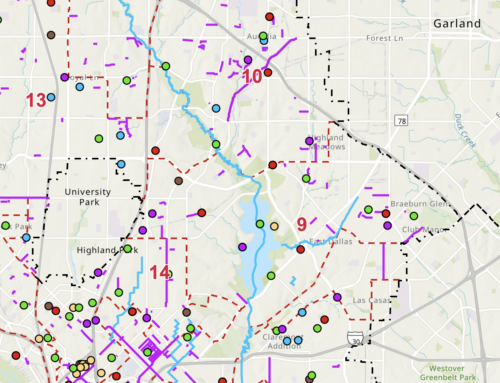Listen well during the next few weeks, because by the end of March there will be no more trains rumbling through Old East Dallas and no more engineers blowing horns to warn motorists off the tracks.
April 1 will mark the end of an era that spans virtually the entire history of East Dallas – and the end of residents’ love-hate relationship with freight trains.
The Santa Fe Railroad has sold about 17 miles of in-town right-of-way for the Atchison, Topeka & Santa Fe tracks to Dallas Area Rapid Transit. Rail traffic will stop operating as of April 1. Trains currently using the tracks will be rerouted.
DART plans to use the Santa Fe right-of-way south of downtown Dallas for its light-rail commuter system, but the section from downtown Dallas to the Southern Pacific Railroad junction at Tenison Park, which cuts through our neighborhoods, will not be used, DART officials say.
“I think we’ll all kind of miss the sounds of the freight trains on the tracks,” says Veletta Forsythe-Lill, immediate past-president of the Hollywood/Santa Monica Neighborhood Association.
However, she and others like Meg Glass who live near the tracks in the Gastonwood/Coronado Hills neighborhood are looking forward to sleeping through the night without hearing long blasts on the train engineer’s horn.
The question now is what to do with the approximately five miles of track that runs through East Dallas.
Residents of neighborhoods bordering the tracks gave a resounding “no” to the idea of using the corridor for DART commuter trains or a toll road in 1988 when the sale was announced. Sentiment is not believed to have changed, says Lill and other East Dallas leaders.
“The citizens of East Dallas were adamantly opposed to commuter rail,” says Michael Campbell, a Dallas appointee to the DART Board and a resident of the Hollywood/Santa Monica neighborhood. “It’s my intent…to see this portion converted to a hike and bike trail. I think it could become an amenity for the city as a whole and certainly for East Dallas.”
Campbell, Dallas City Council members Craig McDaniel and Chris Luna, DART administrators and residents met in late February to discuss this idea and other questions about the future of the Santa Fe corridor.
A greenbelt containing a hike and bike trail seems to be emerging as the favorite option of most residents. If public sentiment continues in that vein, Campbell says he plans to present the idea to the DART Board for a vote in the spring.
If such a trail is approved, and funding is obtained, it would be the second in Dallas. Construction currently is under way to convert about three miles of the Missouri-Kansas-Texas Railroad (or Katy Railroad) right-of-way to a hike and bike trail. The track runs west of Central Expressway between downtown and Mockingbird Lane. The city owns that corridor, and about $1 million in construction funding is being provided by the city, the county and a federal grant.
Community leaders also have their eyes on an abandoned portion of the Southern Pacific Railroad in East Dallas that runs north from Tenison Park on the West side of White Rock Lake. These segments are part of more than 100 miles of former railroad right-of-way that have been abandoned or sold in the Dallas area. It is part of a national trend toward consolidating rail traffic and getting rid of un-needed tracks.
The federal Rails-To-Trails Act allows railroads to donate abandoned right-of-way to a public entity, such as a city or county government, which then maintains it as a public trail. Each year, more than 2,000 miles of American railroad lines are abandoned, and for the past eight years the non-profit Rails-To-Trails Conservancy has been working to get more of them converted to recreational trails. The construction of the Katy Trail in Dallas is part of this program, as are trails in East Texas and other parts of the state.
“I think we need to really look at how people get around and make it possible for people to walk or ride a bike when they want to,” says Bud Melton, an East Dallas bicycle enthusiast and a member of the executive committee of the Texas Trails Network. Melton, who lives in the Mount Auburn neighborhood, envisions one day being able to hike or bike from White Rock Lake to Fair Park and possibly as far south as the Dallas Zoo along railroad right-of-way.
And the dreams don’t stop there. Mary Phinney, administrator for the Dallas County Park and Open Space Program, hopes to propose a county-wide trail plan to the Dallas County Commissioners Court in March. The big picture for the future could see Dallas tied into a national trail system allowing interstate hike and bike travel.
Phinney, who lives in the Mill Creek neighborhood, says the old Santa Fe right-of-way could be a vital and historic connection because much of it follows the path of the original Santa Fe Trail.
“Texas may be left out unless we start planning these connections now,” she says.





